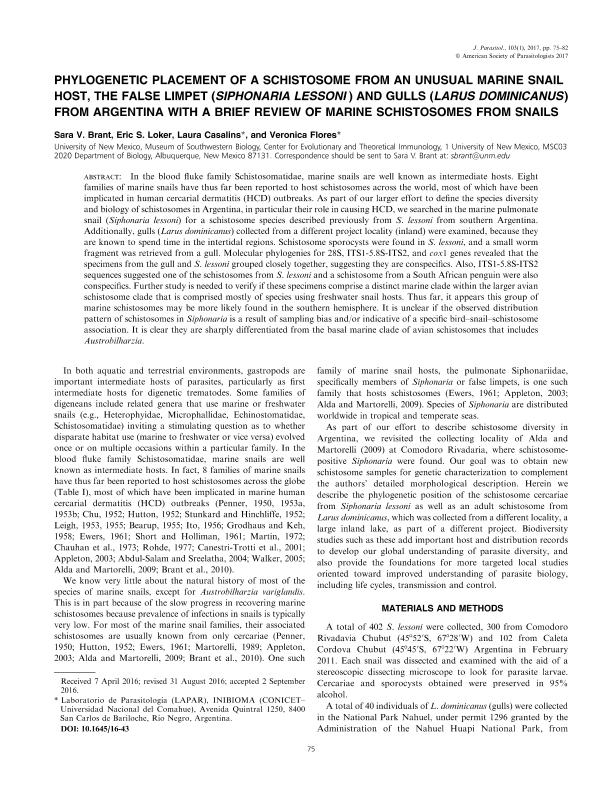Mostrar el registro sencillo del ítem
dc.contributor.author
Brant, Sara V.
dc.contributor.author
Loker, Eric S.
dc.contributor.author
Casalins, Laura

dc.contributor.author
Flores, Verónica Roxana

dc.date.available
2018-09-06T15:13:21Z
dc.date.issued
2017-02
dc.identifier.citation
Brant, Sara V.; Loker, Eric S.; Casalins, Laura; Flores, Verónica Roxana; Phylogenetic placement of a schistosome from an unusual marine snail host, the false limpet (Siphonaria Lessoni ) and gulls (Larus Dominicanus) from Argentina with a brief review of marine schistosomes from snails; American Society of Parasitologists; Journal of Parasitology; 103; 1; 2-2017; 75-82
dc.identifier.issn
0022-3395
dc.identifier.uri
http://hdl.handle.net/11336/58509
dc.description.abstract
In the blood fluke family Schistosomatidae, marine snails are well known as intermediate hosts. Eight families of marine snails have thus far been reported to host schistosomes across the world, most of which have been implicated in human cercarial dermatitis (HCD) outbreaks. As part of our larger effort to define the species diversity and biology of schistosomes in Argentina, in particular their role in causing HCD, we searched in the marine pulmonate snail (Siphonaria lessoni) for a schistosome species described previously from S. lessoni from southern Argentina. Additionally, gulls (Larus dominicanus) collected from a different project locality (inland) were examined, because they are known to spend time in the intertidal regions. Schistosome sporocysts were found in S. lessoni, and a small worm fragment was retrieved from a gull. Molecular phylogenies for 28S, ITS1-5.8S-ITS2, and cox1 genes revealed that the specimens from the gull and S. lessoni grouped closely together, suggesting they are conspecifics. Also, ITS1-5.8S-ITS2 sequences suggested one of the schistosomes from S. lessoni and a schistosome from a South African penguin were also conspecifics. Further study is needed to verify if these specimens comprise a distinct marine clade within the larger avian schistosome clade that is comprised mostly of species using freshwater snail hosts. Thus far, it appears this group of marine schistosomes may be more likely found in the southern hemisphere. It is unclear if the observed distribution pattern of schistosomes in Siphonaria is a result of sampling bias and/or indicative of a specific bird-snail-schistosome association. It is clear they are sharply differentiated from the basal marine clade of avian schistosomes that includes Austrobilharzia.
dc.format
application/pdf
dc.language.iso
eng
dc.publisher
American Society of Parasitologists

dc.rights
info:eu-repo/semantics/openAccess
dc.rights.uri
https://creativecommons.org/licenses/by-nc-sa/2.5/ar/
dc.subject
Siphonaria Lessoni
dc.subject
Larus Dominicanus
dc.subject
Marine
dc.subject
Freshwater
dc.subject.classification
Otras Ciencias Biológicas

dc.subject.classification
Ciencias Biológicas

dc.subject.classification
CIENCIAS NATURALES Y EXACTAS

dc.title
Phylogenetic placement of a schistosome from an unusual marine snail host, the false limpet (Siphonaria Lessoni ) and gulls (Larus Dominicanus) from Argentina with a brief review of marine schistosomes from snails
dc.type
info:eu-repo/semantics/article
dc.type
info:ar-repo/semantics/artículo
dc.type
info:eu-repo/semantics/publishedVersion
dc.date.updated
2018-08-31T13:47:31Z
dc.journal.volume
103
dc.journal.number
1
dc.journal.pagination
75-82
dc.journal.pais
Estados Unidos

dc.journal.ciudad
Washington
dc.description.fil
Fil: Brant, Sara V.. University of New Mexico; Estados Unidos
dc.description.fil
Fil: Loker, Eric S.. University of New Mexico; Estados Unidos
dc.description.fil
Fil: Casalins, Laura. Consejo Nacional de Investigaciones Científicas y Técnicas. Centro Científico Tecnológico Conicet - Patagonia Norte. Instituto de Investigaciones en Biodiversidad y Medioambiente. Universidad Nacional del Comahue. Centro Regional Universidad Bariloche. Instituto de Investigaciones en Biodiversidad y Medioambiente; Argentina. University of New Mexico; Estados Unidos
dc.description.fil
Fil: Flores, Verónica Roxana. Consejo Nacional de Investigaciones Científicas y Técnicas. Centro Científico Tecnológico Conicet - Patagonia Norte. Instituto de Investigaciones en Biodiversidad y Medioambiente. Universidad Nacional del Comahue. Centro Regional Universidad Bariloche. Instituto de Investigaciones en Biodiversidad y Medioambiente; Argentina. University of New Mexico; Estados Unidos
dc.journal.title
Journal of Parasitology

dc.relation.alternativeid
info:eu-repo/semantics/altIdentifier/doi/https://dx.doi.org/10.1645/16-43
dc.relation.alternativeid
info:eu-repo/semantics/altIdentifier/url/http://www.bioone.org/doi/10.1645/16-43
Archivos asociados
